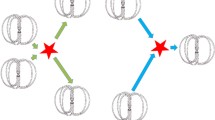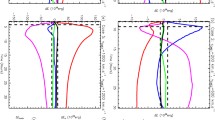Abstract
A super-elastic collision is an unusual process in which some mechanism causes the kinetic energy of the system to increase. Most studies have focused on solid-like objects, and have rarely considered gases or liquids, as the collision of these is primarily a mixing process. However, magnetized plasmoids are different from ordinary gases—as cross-field diffusion is effectively prohibited—but it remains unclear how they behave during a collision. Here we present a comprehensive picture of a unique collision between two coronal mass ejections in the heliosphere, which are the largest magnetized plasmoids erupting from the Sun. Our analysis reveals that these two magnetized plasmoids collided as if they were solid-like objects, with a likelihood of 73% that the collision was super-elastic. The total kinetic energy of the plasmoid system increased by about 6.6% through the collision, significantly influencing its dynamics.





Similar content being viewed by others
References
Bridges, F. G., Hatzes, A. & Lin, D. N. C. Structure, stability and evolution of Saturn’s rings. Nature 309, 333–335 (1984).
Louge, M. Y. & Adams, M. E. Anomalous behavior of normal kinematic restitution in the oblique impacts of a hard sphere on an elastoplastic plate. Phys. Rev. E 65, 021303 (2002).
Kuninaka, H. & Hayakawa, H. Simulation of cohesive head-on collisions of thermally activated nanoclusters. Phys. Rev. E 79, 031309 (2009).
Saitoh, K., Bodrova, A., Hayakawa, H. & Brilliantov, N. V. Negative normal restitution coefficient found in simulation of nanocluster collisions. Phys. Rev. Lett. 105, 238001 (2010).
Kuninaka, H. & Hayakawa, H. Anomalous behavior of the coefficient of normal restitution in oblique impact. Phys. Rev. Lett. 93, 154301 (2004).
Smith, C. E. & Liu, P-P. Coefficients of restitution. J. Appl. Mech. 59, 963–969 (1992).
Calsamiglia, J., Kennedy, S. W., Chatterjee, A., Ruina, A. & Jenkins, J. T. Anomalous frictional behavior in collisions of thin disks. J. Appl. Mech. 66, 146–152 (1999).
Lepping, R. P., Jones, J. A. & Burlaga, L. F. Magnetic field structure of interplanetary magnetic clouds at 1 AU. J. Geophys. Res. 95, 11957–11965 (1990).
Yashiro, S. et al. A catalog of white light coronal mass ejections observed by the soho spacecraft. J. Geophys. Res. 109, A07105 (2004).
Burlaga, L. F., Plunkett, S. P. & St Cyr, O. C. Successive CMEs and complex ejecta. J. Geophys. Res. 107, 1266 (2002).
Wang, Y. M., Wang, S. & Ye, P. Z. Multiple magnetic clouds in interplanetary space. Sol. Phys. 211, 333–344 (2002).
Wang, Y. M., Ye, P. Z. & Wang, S. Multiple magnetic clouds: Several examples during March–April, 2001. J. Geophys. Res. 108, 1370 (2003).
Wang, Y. M., Ye, P. Z., Wang, S. & Xue, X. H. An interplanetary cause of large geomagnetic storms: Fast forward shock overtaking preceding magnetic cloud. Geophys. Res. Lett. 30, 1700 (2003).
Farrugia, C. & Berdichevsky, D. Evolutionary signatures in complex ejecta and their driven shocks. Ann. Geophys. 22, 3679–3698 (2004).
Wang, Y. et al. Impact of the major coronal mass ejections on geo-space during September 7–13, 2005. Astrophys. J. 646, 625–633 (2006).
Harrison, R. A. et al. Two years of the STEREO heliospheric imagers. Invited review. Sol. Phys. 256, 219–237 (2009).
Liu, Y. et al. Geometric triangulation of imaging observations to track coronal mass ejections continuously out to 1 AU. Astrophys. J. 710, L82–L87 (2010).
Liu, Y., Luhmann, J. G., Bale, S. D. & Lin, R. P. Solar source and heliospheric consequences of the 2010 April 3 coronal mass ejection: A comprehensive view. Astrophys. J. 734, 84 (2011).
Gopalswamy, N., Yashiro, S., Kaiser, M. L., Howard, R. A. & Bougeret, J. L. Radio signatures of coronal mass ejection interaction: Coronal mass ejection cannibalism? Astrophys. J. 548, L91–L94 (2001).
Shen, C., Wang, Y., Ye, P. & Wang, S. Enhancement of solar energetic particles during a shock-magnetic cloud interacting complex structure. Sol. Phys. 252, 409–418 (2008).
Lugaz, N., Vourlidas, A. & Roussev, I. I. Deriving the radial distances of wide coronal mass ejections from elongation measurements in the heliosphere application to CME–CME interaction. Ann. Geophys. 27, 3479–3488 (2009).
Liu, Y. D. et al. Interactions between coronal mass ejections viewed in coordinated imaging and in situ observations. Astrophys. J. 746, L15 (2012).
Martı´nez Oliveros, J. C. et al. The 2010 August 01 type II burst: A CME– CME interaction, and its radio and white-light manifestations. Astrophys. J. 748, 66 (2012).
Temmer, M. et al. Characteristics of kinematics of a coronal mass ejection during the 2010 August 1 CME–CME interaction event. Astrophys. J. 749, 57 (2012).
Gonzalez-Esparza, A., Santillán, A. & Ferrer, J. A numerical study of the interaction between two ejecta in the interplanetary medium: one- and two-dimensional hydrodynamic simulations. Ann. Geophys. 22, 3741–3749 (2004).
Schmidt, J. & Cargill, P. A numerical study of two interacting coronal mass ejections. Ann. Geophys. 22, 2245–2254 (2004).
Wang, Y., Zheng, H., Wang, S. & Ye, P. MHD simulation of the formation and propagation of multiple magnetic clouds in the heliosphere. Astron. Astrophys. 434, 309–316 (2005).
Lugaz, N., Manchester, W. B. IV & Gombosi, T. I. Numerical simulation of the interaction of two coronal mass ejections from Sun to Earth. Astrophys. J. 634, 651–662 (2005).
Hayashi, K., Zhao, X-P. & Liu, Y. MHD simulation of two successive interplanetary disturbances driven by cone-model parameters in IPS-based solar wind. Geophys. Res. Lett. 33, 20103 (2006).
Xiong, M., Zheng, H., Wu, S. T., Wang, Y. & Wang, S. Magnetohydrodynamic simulation of the interaction between two interplanetary magnetic clouds and its consequent geoeffectiveness. J. Geophys. Res. 112, A11103 (2007).
Xiong, M., Zheng, H. & Wang, S. Magnetohydrodynamic simulation of the interaction between two interplanetary magnetic clouds and its consequent geoeffectiveness: 2. Oblique collision. J. Geophys. Res. 114, A11101 (2009).
Shen, F. et al. Three-dimensional MHD simulation of two coronal mass ejections’ propagation and interaction using a successive magnetized plasma blobs model. J. Geophys. Res. 116, A09103 (2011).
Howard, R. A. et al. Sun earth connection coronal and heliospheric investigation (SECCHI). Space Sci. Rev. 136, 67–115 (2008).
Kaiser, M. L. et al. The stereo mission: An introduction. Space Sci. Rev. 136, 5–16 (2008).
Kilpua, E. K. J. et al. STEREO observations of interplanetary coronal mass ejections and prominence deflection during solar minimum period. Ann. Geophys. 27, 4491–4503 (2009).
Sheeley, N. R. Jr, Walters, J. H., Wang, Y-M. & Howard, R. A. Continuous tracking of coronal outflows: Two kinds of coronal mass ejections. J. Geophys. Res. 104, 24739–24768 (1999).
Davies, J. A. et al. A synoptic view of solar transient evolution in the inner heliosphere using the heliospheric imagers on STEREO. Geophys. Res. Lett. 36, L02102 (2009).
Liu, Y. et al. Reconstructing coronal mass ejections with coordinated imaging and in situ observations: Global structure, kinematics, and implications for space weather forecasting. Astrophys. J. 722, 1762–1777 (2010).
Lugaz, N. Accuracy and limitations of fitting and stereoscopic methods to determine the direction of coronal mass ejections from heliospheric imagers observations. Sol. Phys. 267, 411–429 (2010).
Lugaz, N. et al. Determining the azimuthal properties of coronal mass ejections from multi-spacecraft remote-sensing observations with STEREO SECCHI. Astrophys. J. 715, 493–499 (2010).
Riley, P. & Crooker, N. U. Kinematic treatment of coronal mass ejection evolution in the solar wind. Astrophys. J. 600, 1035–1042 (2004).
Liu, Y., Richardson, J. D., Belcher, J. W. & Kasper, J. C. Constraints on the global structure of magnetic clouds: Transverse size and curvature. J. Geophys. Res. 111, A12S03 (2006).
Thernisien, A., Howard, R. & Vourlidas, A. Modeling of flux rope coronal mass ejections. Astrophys. J. 652, 763–773 (2006).
Thernisien, A. Implementation of the graduated cylindrical shell model for the three-dimensional reconstruction of coronal mass ejections. Astrophys. J. Suppl. Ser. 194, 33 (2011).
Vourlidas, A., Subramanian, P., Dere, K. P. & Howard, R. A. Large-angle spectrometric coronagraph measurements of the energetics of coronal mass ejections. Astrophys. J. 534, 456–467 (2000).
Hundhausen, A. J. Sizes and locations of coronal mass ejections—SMM observations from 1980 and 1984–1989. J. Geophys. Res. 98, 13177–13200 (1993).
Vourlidas, A. & Howard, R. A. The proper treatment of coronal mass ejection brightness: A new methodology and implications for observations. Astrophys. J. 642, 1216–1221 (2006).
Kumar, A. & Rust, D. M. Interplanetary magnetic clouds, helicity conservation, and current-core flux-ropes. J. Geophys. Res. 101, 15667–15684 (1996).
Wang, Y., Zhang, J. & Shen, C. An analytical model probing the internal state of coronal mass ejections based on observations of their expansions and propagations. J. Geophys. Res. 114, A10104 (2009).
Hayakawa, H. & Kuninaka, H. Theory of the inelastic impact of elastic materials. Phase Transit. 77, 889–909 (2004).
Acknowledgements
We acknowledge the use of data from the SECCHI, IMPACT, PLASTIC and WAVES instruments on STEREO, LASCO on SOHO and WAVES on WIND. STEREO is the third mission in NASA’s Solar Terrestrial Probes programme, and SOHO is a mission of international cooperation between ESA and NASA. Y.W. also thanks N. Lugaz for some valuable discussion. This work is supported by grants from the 973 key project 2011CB811403, NSFC 41131065, 40904046, 40874075 and 41121003, CAS the Key Research Program KZZD-EW-01, 100-talent program, KZCX2-YW-QN511 and start-up fund, and MOEC 20113402110001 and the fundamental research funds for the central universities.
Author information
Authors and Affiliations
Contributions
Y.W. designed the analysis of the collision and performed the theoretical derivations. C.S. found this event and carried out the data processing and calculations. S.W. gave constructive suggestions on the analysis of the collision. Y.L. gave some advice on the construction of the J-map and interpretation of the elongation angle. B.M. carried out the literature investigation and provided valuable additions. A.V. calculated the masses of the CMEs and gave many valuable suggestions. R.L. and P.Y. participated in the discussion and gave many suggestions. J.L. and Z.Z. made a contribution to the data analysis.
Corresponding author
Ethics declarations
Competing interests
The authors declare no competing financial interests.
Supplementary information
Supplementary Information
Supplementary Information (PDF 17185 kb)
Supplementary Movie
Supplementary Movie 1 (MP4 123767 kb)
Supplementary Movie
Supplementary Movie 2 (MP4 6659 kb)
Rights and permissions
About this article
Cite this article
Shen, C., Wang, Y., Wang, S. et al. Super-elastic collision of large-scale magnetized plasmoids in the heliosphere. Nature Phys 8, 923–928 (2012). https://doi.org/10.1038/nphys2440
Received:
Accepted:
Published:
Issue Date:
DOI: https://doi.org/10.1038/nphys2440
- Springer Nature Limited
This article is cited by
-
Propagation of coronal mass ejections from the Sun to the Earth
Journal of Astrophysics and Astronomy (2023)
-
Propagation characteristics of coronal mass ejections (CMEs) in the corona and interplanetary space
Reviews of Modern Plasma Physics (2022)
-
Earth-affecting solar transients: a review of progresses in solar cycle 24
Progress in Earth and Planetary Science (2021)
-
Three-Dimensional Simulations of Solar Wind Preconditioning and the 23 July 2012 Interplanetary Coronal Mass Ejection
Solar Physics (2020)
-
Concept of the solar ring mission: An overview
Science China Technological Sciences (2020)





